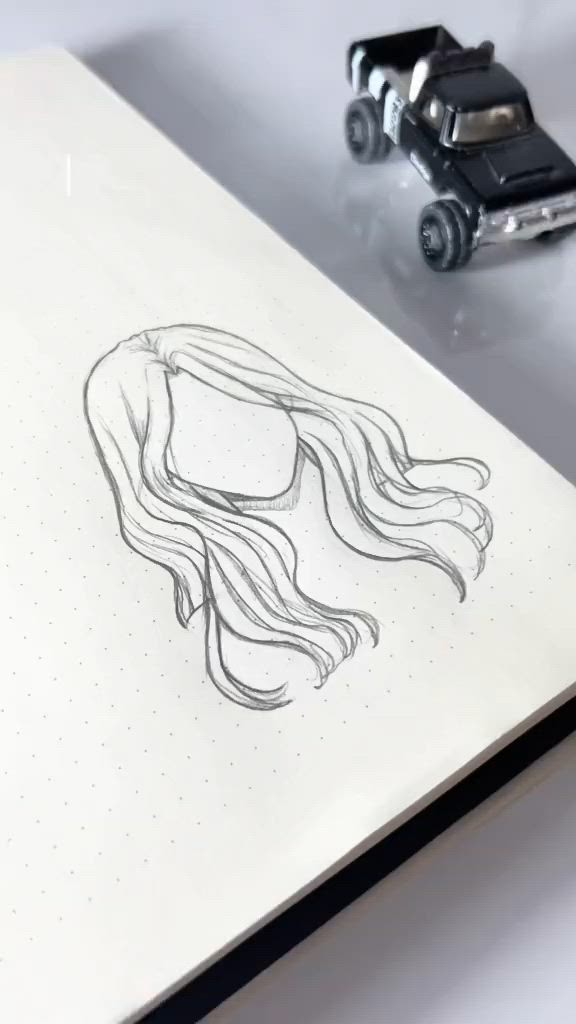Easy Hair Drawing: A Comprehensive Art Tutorial
Drawing hair can be one of the most challenging aspects of creating realistic portraits. With its complex structure and varying textures, hair might seem intimidating, but with some easy-to-follow steps, you can master this art. Whether you're a beginner or looking to refine your skills, this guide will provide you with a solid foundation for drawing hair.
Understanding Hair Structure
Before diving into drawing, it’s crucial to understand the basic structure of hair. Hair grows in strands, each of which has its own texture and flow. Hair can be straight, wavy, curly, or kinky, and each type requires a different approach in drawing.
Hair Follicles and Strands: Hair grows from follicles and appears as individual strands. These strands group together and flow in different directions depending on the hairstyle.
Layering: Hair typically has layers, with shorter strands on top and longer strands underneath. This layering creates volume and dimension.
Essential Tools
To get started, gather the following tools:
Pencil: Use a range of pencils (H, B, 2B, etc.) for different shades and textures.
Paper: A smooth sketching paper works well for detailed drawings.
Eraser: A kneaded eraser is excellent for creating highlights and cleaning up areas.
Blending Tools: Blending stumps or tortillons help smooth out pencil strokes.
Step-by-Step Tutorial
1. Basic Outline
Start with a simple outline of the head and the hairline. Lightly sketch the basic shape of the hairstyle. Pay attention to the hair’s direction and flow. For example, if drawing long, flowing hair, sketch long, curved lines to indicate how the hair will fall.
2. Add Guidelines
Within your outline, add guidelines for the direction of the hair strands. These lines should follow the natural growth pattern of the hair. For straight hair, lines will be more parallel. For curly hair, lines should be wavy or spiral.
3. Define the Hair Strands
Begin adding detail by drawing individual strands of hair. Use light, quick strokes to create the appearance of texture. Follow the guidelines to ensure the hair flows naturally. Vary your pressure to create different shades and depths. For finer details, use a sharper pencil or a pen.
4. Add Volume and Texture
To create the illusion of volume, add more layers of hair. Darken areas where shadows fall and lighten areas where light hits. Use a blending tool to smooth out the pencil strokes, but be careful not to over-blend; the texture should still be visible.
5. Refine and Detail
Refine your drawing by adding more details to individual strands. Focus on areas where the hair overlaps and where light creates highlights. Use your eraser to lift some graphite to create realistic highlights and to clean up any mistakes.
6. Final Touches
Once you’re satisfied with the hair, add any final details to enhance the realism. This could include refining the hairline, adding small stray hairs, or adjusting the shading to balance the overall composition.
Tips for Different Hair Types
Straight Hair: Use long, smooth strokes. The lines should be straight and parallel, with subtle changes in thickness to indicate texture and movement.
Curly Hair: Draw spirals and loops. Emphasize the direction of the curls and use varying pencil pressures to capture the bounce and volume.
Wavy Hair: Create gentle, flowing curves. Vary the stroke direction to show the natural wave pattern.
Kinky Hair: Use tight, small curls and zigzag lines to illustrate the coiled nature. Be sure to show the density and volume.
Common Mistakes to Avoid
Over-Detailing: Too much detail can make hair look stiff. Aim for a balance between detail and fluidity.
Ignoring Light and Shadow: Without proper shading, hair can appear flat. Pay attention to light sources and how they affect the hair’s appearance.
Uniform Strands: Hair is rarely uniform. Introduce variation in the thickness and length of strands for a more natural look.
Practice Makes Perfect
Drawing hair takes practice. Experiment with different styles and techniques to find what works best for you. Study real hair, practice regularly, and don’t be afraid to make mistakes. Each drawing will improve your skills and confidence.
By following these steps and practicing regularly, you can master the art of drawing hair and bring your portraits to life. Happy drawing!






